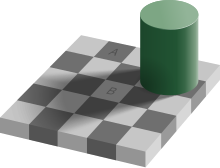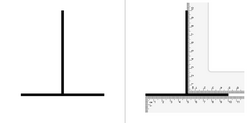The checker shadow illusion. Although square A appears a darker shade of grey than square B, in the image the two have exactly the same luminance.
Drawing a connecting bar between the two squares breaks the illusion and shows that they are the same shade.
Gregory’s categorization of illusions
In this animation, Mach bands exaggerate the contrast between edges of the slightly differing shades of gray, as soon as they come in contact with one-another.
An optical illusion (also called a visual illusion)
is an illusion caused by the visual system and characterized by a visual percept that (loosely said) appears to differ from reality. Illusions come in a wide variety; their categorization is difficult because the underlying cause is often not clear but a classification proposed by Richard Gregory
is useful as an orientation. According to that, there are three main
classes: physical, physiological, and cognitive illusions, and in each
class there are four kinds: Ambiguities, distortions, paradoxes, and
fictions. A classical example for a physical distortion would be the
apparent bending of a stick half immerged in water; an example for a
physiological paradox is the motion aftereffect (where despite movement position remains unchanged). An example for a physiological fiction is an afterimage. Three typical cognitive distortions are the Ponzo, Poggendorff, and Müller-Lyer
illusion. Physical illusions are caused by the physical environment,
e.g. by the optical properties of water. Physiological illusions arise
in the eye or the visual pathway, e.g. from the effects of excessive
stimulation of a specific receptor type. Cognitive visual illusions are the result of unconscious inferences and are perhaps those most widely known.
Pathological visual illusions arise from pathological changes in the physiological visual perception mechanisms causing the aforementioned types of illusions; they are discussed e.g. under visual hallucinations.
Physical visual illusions
A
familiar phenomenon an example for a physical visual illusion are when
mountains appear to be much nearer in clear weather with low humidity (Foehn) than they are. This is because haze is a cue for depth perception for far-away objects (Aerial perspective).
The classical example of a physical illusion is when a stick that
is half immersed in water appears bent. This phenomenon has already
been discussed by Ptolemy (ca. 150) and was often a prototypical example for an illusion.
Physiological visual illusions
Physiological illusions, such as the afterimages following bright lights, or adapting stimuli of excessively longer alternating patterns (contingent perceptual aftereffect),
are presumed to be the effects on the eyes or brain of excessive
stimulation or interaction with contextual or competing stimuli of a
specific type—brightness, color, position, tile, size, movement, etc.
The theory is that a stimulus follows its individual dedicated neural
path in the early stages of visual processing and that intense or
repetitive activity in that or interaction with active adjoining
channels causes a physiological imbalance that alters perception.
The Hermann grid illusion and Mach bands are two illusions that are best explained using a biological approach. Lateral inhibition, where in the receptive field
of the retina light and dark receptors compete with one another to
become active, has been used to explain why we see bands of increased
brightness at the edge of a color difference when viewing Mach bands.
Once a receptor is active, it inhibits adjacent receptors. This
inhibition creates contrast, highlighting edges. In the Hermann grid
illusion the gray spots appear at the intersection because of the
inhibitory response which occurs as a result of the increased dark
surround. Lateral inhibition has also been used to explain the Hermann grid illusion, but this has been disproved.
More recent empirical approaches
to optical illusions have had some success in explaining optical
phenomena with which theories based on lateral inhibition have
struggled.
Cognitive illusions
"The Organ Player" - Pareidolia phenomenon in Neptune's Grotto stalactite cave (Alghero, Sardinia)
Cognitive illusions are assumed to arise by interaction with
assumptions about the world, leading to "unconscious inferences", an
idea first suggested in the 19th century by the German physicist and physician Hermann Helmholtz. Cognitive illusions are commonly divided into ambiguous illusions, distorting illusions, paradox illusions, or fiction illusions.
- Ambiguous illusions are pictures or objects that elicit a perceptual "switch" between the alternative interpretations. The Necker cube is a well-known example; another instance is the Rubin vase.
- Distorting or geometrical-optical illusions are characterized by distortions of size, length, position or curvature. A striking example is the Café wall illusion. Other examples are the famous Müller-Lyer illusion and Ponzo illusion.
- Paradox illusions are generated by objects that are paradoxical or impossible, such as the Penrose triangle or impossible staircase seen, for example, in M. C. Escher's Ascending and Descending and Waterfall. The triangle is an illusion dependent on a cognitive misunderstanding that adjacent edges must join.
- Fictions are when a figure is perceived even though it is not in the stimulus.
Explanation of cognitive illusions
Perceptual organization
Reversible figures and vase, or the figure-ground illusion
To make sense of the world it is necessary to organize incoming sensations into information which is meaningful. Gestalt psychologists believe one way this is done is by perceiving individual sensory stimuli as a meaningful whole. Gestalt organization can be used to explain many illusions including the rabbit–duck illusion where the image as a whole switches back and forth from being a duck then being a rabbit and why in the figure–ground illusion the figure and ground are reversible.
In addition, Gestalt theory can be used to explain the illusory contours in the Kanizsa's Triangle.
A floating white triangle, which does not exist, is seen. The brain has
a need to see familiar simple objects and has a tendency to create a
"whole" image from individual elements. Gestalt means "form" or "shape" in German. However, another explanation of the Kanizsa's Triangle is based in evolutionary psychology
and the fact that in order to survive it was important to see form and
edges. The use of perceptual organization to create meaning out of
stimuli is the principle behind other well-known illusions including impossible objects.
Our brain makes sense of shapes and symbols putting them together like a
jigsaw puzzle, formulating that which isn't there to that which is
believable.
The Gestalt principles of perception govern the way we group
different objects. Good form is where the perceptual system tries to
fill in the blanks in order to see simple objects rather than complex
objects. Continuity is where the perceptual system tries to disambiguate
which segments fit together into continuous lines. Proximity is where
objects that are close together are associated. Similarity is where
objects that are similar are seen as associated. Some of these elements
have been successfully incorporated into quantitative models involving
optimal estimation or Bayesian inference.
The double-anchoring theory, a popular but recent theory of
lightness illusions, states that any region belongs to one or more
frameworks, created by Gestalt grouping principles, and within each
frame is independently anchored to both the highest luminance and the
surround luminance. A spot's lightness is determined by the average of
the values computed in each framework.
Depth and motion perception
The vertical–horizontal illusion where the vertical line is thought to be longer than the horizontal
Illusions can be based on an individual's ability to see in three
dimensions even though the image hitting the retina is only two
dimensional. The Ponzo illusion
is an example of an illusion which uses monocular cues of depth
perception to fool the eye. But even with two-dimensional images, the
brain exaggerates vertical distances when compared with horizontal
distances, as in the vertical-horizontal illusion where the two lines are exactly the same length.
In the Ponzo illusion the converging parallel lines tell the brain that the image higher in the visual field is farther away, therefore, the brain perceives the image to be larger, although the two images hitting the retina are the same size. The optical illusion seen in a diorama/false perspective also exploits assumptions based on monocular cues of depth perception. The M.C. Escher painting Waterfall exploits rules of depth and proximity and our understanding of the physical world to create an illusion. Like depth perception, motion perception is responsible for a number of sensory illusions. Film animation
is based on the illusion that the brain perceives a series of slightly
varied images produced in rapid succession as a moving picture.
Likewise, when we are moving, as we would be while riding in a vehicle,
stable surrounding objects may appear to move. We may also perceive a
large object, like an airplane, to move more slowly than smaller
objects, like a car, although the larger object is actually moving
faster. The phi phenomenon is yet another example of how the brain perceives motion, which is most often created by blinking lights in close succession.
The ambiguity of direction of motion due to lack of visual references for depth is shown in the spinning dancer illusion.
The spinning dancer appears to be moving clockwise or counterclockwise
depending on spontaneous activity in the brain where perception is
subjective. Recent studies show on the fMRI that there are spontaneous
fluctuations in cortical activity while watching this illusion,
particularly the parietal lobe because it is involved in perceiving
movement.
Color and brightness constancy
Simultaneous Contrast Illusion. The background is a color gradient
and progresses from dark grey to light grey. The horizontal bar appears
to progress from light grey to dark grey, but is in fact just one
color.
Perceptual constancies are sources of illusions. Color constancy
and brightness constancy are responsible for the fact that a familiar
object will appear the same color regardless of the amount of light or
color of light reflecting from it. An illusion of color difference or
luminosity difference can be created when the luminosity or color of the
area surrounding an unfamiliar object is changed. The luminosity of the
object will appear brighter against a black field (that reflects less
light) compared to a white field, even though the object itself did not
change in luminosity. Similarly, the eye will compensate for color
contrast depending on the color cast of the surrounding area.
In addition to the Gestalt principles of perception, water-color
illusions contribute to the formation of optical illusions. Water-color
illusions consist of object-hole effects and coloration. Object-hole
effects occur when boundaries are prominent where there is a figure and
background with a hole that is 3D volumetric in appearance. Coloration
consists of an assimilation of color radiating from a thin-colored edge
lining a darker chromatic contour. The water-color illusion describes
how the human mind perceives the wholeness of an object such as top-down
processing. Thus, contextual factors play into perceiving the
brightness of an object.
Object
Just as
it perceives color and brightness constancy, the brain has the ability
to understand familiar objects as having a consistent shape or size.
For example, a door is perceived as a rectangle regardless of how the
image may change on the retina as the door is opened and closed.
Unfamiliar objects, however, do not always follow the rules of shape
constancy and may change when the perspective is changed. The Shepard
illusion of the changing table is an example of an illusion based on distortions in shape constancy.
Future perception
Optical illusion
Researcher Mark Changizi of Rensselaer Polytechnic Institute
in New York has a more imaginative take on optical illusions, saying
that they are due to a neural lag which most humans experience while
awake. When light hits the retina, about one-tenth of a second goes by
before the brain translates the signal into a visual perception of the
world. Scientists have known of the lag, yet they have debated how
humans compensate, with some proposing that our motor system somehow
modifies our movements to offset the delay.
Changizi asserts that the human visual system has evolved to
compensate for neural delays by generating images of what will occur
one-tenth of a second into the future. This foresight enables humans to
react to events in the present, enabling humans to perform reflexive
acts like catching a fly ball and to maneuver smoothly through a crowd.
In an interview with ABC Changizi said, "Illusions occur when our
brains attempt to perceive the future, and those perceptions don't match
reality." For example, an illusion called the Hering illusion
looks like bicycle spokes around a central point, with vertical lines
on either side of this central, so-called vanishing point.
The illusion tricks us into thinking we are looking at a perspective
picture, and thus according to Changizi, switches on our future-seeing
abilities. Since we aren't actually moving and the figure is static, we
misperceive the straight lines as curved ones.
Changizi said:
Evolution has seen to it that geometric drawings like this elicit in us premonitions of the near future. The converging lines toward a vanishing point (the spokes) are cues that trick our brains into thinking we are moving forward—as we would in the real world, where the door frame (a pair of vertical lines) seems to bow out as we move through it—and we try to perceive what that world will look like in the next instant.
Pathological visual illusions
A pathological visual illusion is a distortion of a real external stimulus
and are often diffuse and persistent. Pathological visual illusions
usually occur throughout the visual field, suggesting global
excitability or sensitivity alterations. Alternatively visual hallucination is the perception of an external visual stimulus where none exists. Visual hallucinations are often from focal dysfunction and are usually transient.
Types of visual illusions include oscillopsia, halos around objects, illusory palinopsia (visual trailing, light streaking, prolonged indistinct afterimages), akinetopsia, visual snow, micropsia, macropsia, teleopsia, pelopsia, Alice in Wonderland syndrome, metamorphopsia, dyschromatopsia, intense glare, blue field entoptic phenomenon, and purkinje trees.
These symptoms may indicate an underlying disease state and
necessitate seeing a medical practitioner. Etiologies associated with
pathological visual illusions include multiple types of ocular disease, migraines, hallucinogen persisting perception disorder, head trauma, and prescription drugs.
If a medical work-up does not reveal a cause of the pathological visual
illusions, the idiopathic visual disturbances could be analogous to the
altered excitability state seen in visual aura with no migraine
headache. If the visual illusions are diffuse and persistent, they often
affect the patient's quality of life. These symptoms are often
refractory to treatment and may be caused by any of the aforementioned
etiologes, but are often idiopathic. There is no standard treatment for
these visual disturbances.
List of illusions
There are a variety of different types of optical illusions. Many are included in the following list.
In art
Artists who have worked with optical illusions include M. C. Escher, Bridget Riley, Salvador Dalí, Giuseppe Arcimboldo, Patrick Bokanowski, Marcel Duchamp, Jasper Johns, Oscar Reutersvärd, Victor Vasarely and Charles Allan Gilbert. Contemporary artists who have experimented with illusions include Jonty Hurwitz, Sandro del Prete, Octavio Ocampo, Dick Termes, Shigeo Fukuda, Patrick Hughes, István Orosz, Rob Gonsalves, Gianni A. Sarcone, Ben Heine and Akiyoshi Kitaoka. Optical illusion is also used in film by the technique of forced perspective.
Op art is a style of art that uses optical illusions to create an impression of movement, or hidden images and patterns. Trompe-l'œil
uses realistic imagery to create the optical illusion that depicted objects exist in three dimensions.
Cognitive processes hypothesis
The
hypothesis claims that visual illusions occur because the neural
circuitry in our visual system evolves, by neural learning, to a system
that makes very efficient interpretations of usual 3D scenes based in
the emergence of simplified models in our brain that speed up the
interpretation process but give rise to optical illusions in unusual
situations. In this sense, the cognitive processes hypothesis can be
considered a framework for an understanding of optical illusions as the
signature of the empirical statistical way vision has evolved to solve
the inverse problem.
Research indicates that 3D vision capabilities emerge and are
learned jointly with the planning of movements. After a long process of
learning, an internal representation of the world emerges that is
well-adjusted to the perceived data coming from closer objects. The
representation of distant objects near the horizon is less "adequate".
In fact, it is not only the Moon that seems larger when we perceive it
near the horizon. In a photo of a distant scene, all distant objects are
perceived as smaller than when we observe them directly using our
vision.
The retinal image is the main source driving vision but what we
see is a "virtual" 3D representation of the scene in front of us. We
don't see a physical image of the world; we see objects, and the
physical world is not itself separated into objects. We see it according
to the way our brain organizes it. The names, colors, usual shapes and
other information about the things we see pop up instantaneously from
our neural circuitry and influence the representation of the scene. We
"see" the most relevant information about the elements of the best 3D
image that our neural networks can produce. The illusions arise when
the "judgments" implied in the unconscious analysis of the scene are in
conflict with reasoned considerations about it.












